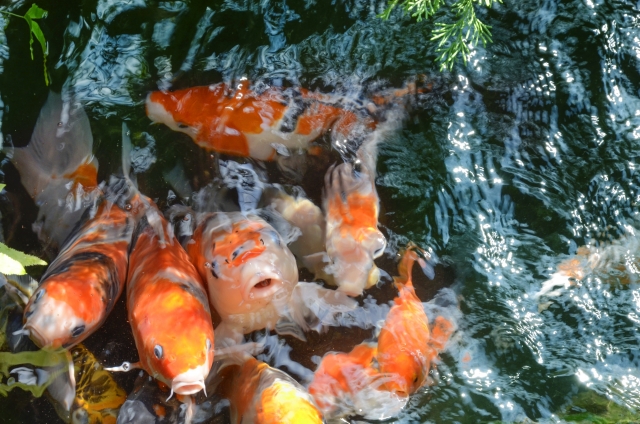Visited Vietnam History Museum in Ho Chi Minh as well. When traveling abroad, I make it a rule to go visit the country’s national museum. Surveying its history and relations with the neighboring countries, and tracking back the ruins, handcrafts, and artworks that were born and protected cherishingly for centuries, then I am able to make visual and visionary image toward the country.
ホーチミンでは、ベトナム歴史博物館へも行ってきた。海外旅行の際、訪れた国の国立博物館へは可能な限り行くようにしている。一国の歴史や周辺諸国との関係性を、時代を辿りつつその国で生まれ大切に守られ続けて来た遺跡や工芸品や美術品から見てゆくと、その国に対する像を自分の頭の中で形作ってゆくことが出来るからだ。

Now I’m creating Japanography, and come to have a perspective of correlation of Japan and the country. And walking around, feeling touched, and connecting various inspirations and incidents while looking for hints to establish genuinely original point of view.
ジャパノグラフィー®️を作るようになってからは、その異国と日本の相互関係という視点も入ってくるようになった。そして歩き回って、感じ入って、色んな着想と事物を結びつけながら、自分なりの視座を確立するためのヒントを探す。

In Vietnam History Museum, there was floating one of a kind atmosphere that was entangled with Vietnamese, Chinese, and French style intricately and complicatedly coexisting. Stunningly beautiful.
ベトナム歴史博物館は、ベトナム様式と中国様式とフランス様式が渾然一体となり、長い年月を経たのちの風雪に耐えた佇まいが、非常に美しい趣を醸し出している。


The exhibition of Buddhism art given birth in India, later expanded to China, Korea, Vietnam, Thai, Myanmar, Cambodia, Laos, and Japan via Silk Road, and how it developed in Vietnam was intriguing and enthralling.
インドで生まれ、シルクロードを通り、中国、朝鮮、ベトナム(越南)、タイ、ミャンマー、カンボジア、ラオスへ広がり、日本へも伝来した仏教美術が、ベトナムの地でどのように作られたかの展示が非常に面白かった。




Statues of Buddha, that I’ve appreciated in Japan; Kyushu, Tohoku, and ancient capital of Nara, Kyoto, Kamakura looked merciful or mystical or sublime, they are coated with some kind of authoritarianism. Their expressions are plain, seemed like transcended form human world, and the phase of Nirvana was expressed.
日本でこれまでに見てきた、九州や東北や古都奈良、京都、鎌倉の仏像は、荘厳でまじめで慈悲深いような、ありがたいというか近寄り難いというか、権威主義のようなものを纏っていて、どちらかといえば無表情に近いものがあった。感情というものを超越し人間界から解脱した、涅槃の境地が表現されていたように思う。


Compared with that, statues of Buddha in Vietnam were more humane and real. Just the same as you and me, not overly serious, they even looked joking around and making a grin. Is this characteristics of Vietnam? Buddha was innately a human who had rich and bountiful emotions, people have this mutual understanding in the background?
それに比べてベトナムの仏像は、ありのままの感情を持った人間臭い表情が多いような感じがした。真面目くさっていないいないというか、或いは少しふざけてほくそ笑んでいる様なものも多くて驚いた。これもお国柄なのだろうか。仏像と言えども、元はと言えば豊かな感情を持った生身の人間なのだ、という考えが背景にはあるのだろうか。

I’m interested in the transition of expressions of Buddha crossing over Silk Road. Researchers of Buddhism and Zen go to filed work in Vietnam, Cambodia, China, Thai, Myanmar, and Korea, then confront with numerous statues of Buddha and make a survey, read thesis, and make original hypothesis, and endeavor to prove it by verbalizing devoting whole life. I listened to the lectures in graduate school and conference presentation, thought the life of intellectual adventurer, border crosser was stimulating.
シルクロードを渡るにつれて、変化して行った仏像の表情に興味を抱く。仏教や禅の研究者の方は、ベトナムやカンボジアや中国やタイやミャンマーや韓国に出かけ、多くの仏像と対峙して調査をして論文を読み込み、自分なりの新しい仮説を立て、それを言語化して証明することに一生をかけたりする人もいる。大学院での講義や学会発表を聞いて、そういう知の冒険者、越境者の生き方も面白いと思ったりもした。

On the contrary, my studies of Japanography doesn’t pursue one area rigidly and rigorously piling up intricate image. Rather than that I deal with every possible phenomenon and factors regarding Japan like a kaleidoscope, linking history and modernity, at times connecting Japan and abroad, contemplating freely and digging up deeply, playing with images and inspirations mix and mingling, then making descriptions of Japanese culture. Of course, while keeping some restrictions.
一方、私のジャパノグラフィー®️研究は、一つの領域を精緻にどこまでも掘り下げて深度を増してゆくというよりも、日本に関するありとあらゆる現象事象を万華鏡の様に取り上げて、歴史と現代を結んで、時に日本と海外を繋げて、自由自在に思考し、時に深掘りしつつ、時に着想同士を掛け合わせて遊びつつ、日本文化を記述してゆくというものだ。勿論、一定の制約は守りつつ。

The rules are 3 pillars of Japangraphy that I constructed.
その制約というのは、自分で作ったジャパノグラフィーの三本柱である。
*Write each article all in English/Japanese bilingual on one’s accord for educational purpose with free ideas
*Fix personal viewpoint, go fieldwork, take photos all by oneself, and write article after reading reference book(s)
*Adopt Cultural Relativism and respect foreign culture as well as Japanese culture
*教育目的で日本語と英語のバイリンガル記事を個人で全て書き、自由な着想を持つ
*個人の視点を基軸に、全て自身で取材をして写真を撮り、参考文献を読んだ上で書く
*文化相対主義を採用し、日本文化だけでなく異文化への尊敬も持つ
Other than that, I play improvising like a jazz musician enjoy swing freely. And persevering to make profound study ceaselessly, and believing I’m polishing craftsmanship of shuffling infinite numbers of cards.
それ以外は、自由にジャズ奏者がスイングを楽しむように、私も即興演奏をしている。絶えず自己研鑽に励んでいるので、無限の手札を繰り出せるシャフリングの技術は常に磨いているつもりだ。
And as a manner of creation, one draws a blue print widely firsthand, and completes the picture making details perfectly. However, having the answer in the beginning and move toward the target is lacking in freshness of surprise, discovery, and crispness.
ものづくりのお手前として、まず初めに大きく設計図を描き、細部を詰めて画を完成させて行くという手法があるけれど、初めに解ありきでそこに向かって行くというものは、どうしたって驚き!発見!瑞々しさ!という鮮度が濁ってしまうみたいだ。
Making trial and errors while bumping into countless obstacles then moving forward with simple honesty can be far form elegance, and the efficiency can be costly. Nonetheless, you can be free from lukewarm pre-established harmony.
手探りでなんとかかんとか、ゴチゴチゴッツンと色んな障壁にぶつかりながら愚直に進むのは、スマートさからは程遠いし、効率だってよろしくはない。けれど、予定調和のヌルさみたいなものとは無縁でいられる。
Authoritarianism of Japanese Academia is surprisingly exclusive, they are resistant to admit my studies of outside. Therefore, I’m transforming the strategy, I decided to go dashing with the speed that no one can compete, run and run and run while polishing up originality to the maximum, and pile up accomplishments indisputably.
日本のアカデミズムの権威主義の世界は驚くほどに排他的で、なかなか在野の私の研究を認めようとしてくれないので、そこは作戦を変えて、誰にも追いつけないほどの速度で独走して走りに走って無双して、独創性を磨きに磨いてビカビカにしておいて、誰も真似できないほどの実績を確実に積み上げておくことにした。
I complete making Japanography dedicating my whole life. But no worries, the studies is recorded and updated in National Diet Library, Japan as a document of the country, and I’m determined to achieve to research results that no Academicians can accomplish. When people come to recognize it, it will be surely overwhelming, so look forward to it! I’m defiant 100%.
人生かけてジャパノグラフィー®️を完成させるのだ。大丈夫、国立国会図書館に国の資料として私の研究は記録更新され続けてゆくのだから、アカデミズムの世界の住人たちには到底真似できないほどの研究成果を挙げてやるから、やっと気づいて認めた時には凄いことになっているから、楽しみにしていなさい!と啖呵を切る。
The statues of Buddha in Vietnam History Museum were strikingly free and not trapped in formalities. They looked like scheming something on the back and giving a fearless grin. Not only one or two. I also plan out uniquely and exceptionally, spread my wings wide and fly high. The intellectual adventure to complete creating Japanography is ceaselessly proceeding.
ベトナム歴史博物館で見て来た仏像たちは驚くほどに自由で、堅苦しさに囚われていなかった。何かを企んでいるような、ニヤリと不敵な笑みを浮かべているものも、一つや二つではなかった。私もあり得ないほどにユニークに画策して、翼を広げ高く飛ぶのだ。ジャパノグラフィー®️を作り上げる知の冒険はこれからも続いてゆく。
To be continued…
つづく
Love and Peace!






















